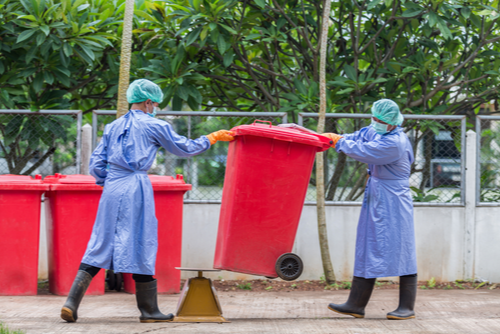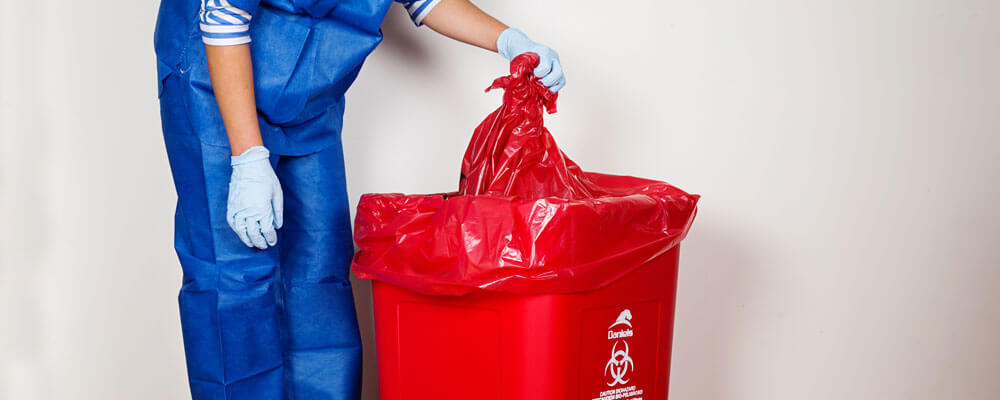Guardians of Tidiness: Resident Medical Waste Removal Service for Your Comfort
Guardians of Tidiness: Resident Medical Waste Removal Service for Your Comfort
Blog Article
The Significance of Proper Medical Waste Disposal: An Overview for Health Care Facilities
Appropriate clinical garbage disposal is a vital element of healthcare center administration, making certain the safety and security and health of individuals, team, and the environment. From comprehending the different groups of clinical waste to complying with regulatory demands, medical care facilities need to adopt reliable waste segregation methods and select suitable disposal approaches. The relevance of proper medical waste disposal goes past simple conformity; it is a duty that needs ongoing training and education for staff. In this guide, we will check out the different elements of medical garbage disposal and highlight the crucial actions that healthcare centers need to take. By applying these practices, medical care centers can minimize risks, secure public health, and add to a cleaner, safer atmosphere.
Comprehending Medical Waste Categories
Recognizing medical waste classifications is vital for appropriate disposal in health care facilities. Medical waste is a broad term that encompasses different types of waste created in healthcare settings, such as labs, clinics, and medical facilities. Classifying clinical waste helps make sure that it is managed, kept, and disposed of securely and based on appropriate guidelines.
There are numerous groups of medical waste that medical care facilities need to be knowledgeable about. These classifications consist of infectious waste, sharps waste, pharmaceutical waste, chemical waste, and radioactive waste (medical waste disposal services with WasteX). Each category has details characteristics and requires different disposal approaches to lessen the threat of damage to medical care workers, patients, and the setting
Transmittable waste, for instance, refers to lose infected with possibly contagious materials, such as blood, body fluids, and tissues. Drug waste consists of run out or unused medicines, while chemical waste consists of dangerous chemicals utilized in medical treatments.
Conformity With Regulatory Needs
Health care centers must ensure conformity with regulative needs for correct medical garbage disposal. Regulatory bodies, such as the Epa (EPA) and the Occupational Safety And Security and Wellness Administration (OSHA), have established laws and guidelines to protect public wellness and the environment. These laws describe the correct handling, storage space, transport, and disposal of medical waste.
Conformity with regulatory demands is important for medical care centers to prevent lawful fines, reputational damages, and prospective damage to human wellness and the environment. Failing to conform with these guidelines can result in fines, suits, and also the suspension or retraction of running licenses.
To make certain conformity, medical care centers must develop thorough waste administration programs that include team training, proper waste segregation, and using suitable containers and labels. Normal audits and examinations must also be carried out to identify any non-compliance problems and address them immediately.
It is important for health care centers to keep up to day with changes in regulations and upgrade their waste monitoring techniques as necessary. This can be accomplished by proactively keeping track of updates from regulatory bodies and joining training programs and workshops.
Executing Reliable Waste Segregation Practices
To make sure correct medical waste disposal, medical care facilities have to apply effective waste partition methods. Waste segregation is a crucial action in the general waste administration process, as it helps decrease the danger of infection, avoids cross-contamination, and guarantees the safe disposal of various types of waste. Efficient waste partition practices entail dividing medical waste right into different classifications based upon its features and potential dangers.
One common method is the segregation of sharps waste, such as scalpels and needles, from other kinds of medical waste. Sharps waste must be positioned in puncture-resistant containers to stop injuries and potential infections. Additionally, unsafe waste, such as drugs and chemicals, should be separated from basic clinical waste to stop ecological contamination.
Proper labeling and color-coding of waste containers are necessary for effective waste segregation. Visible and clear tags ought to be positioned on each container to show the type of waste it consists of and any type of special delivery demands - medical waste disposal services with WasteX. Furthermore, color-coding can be made use of to differentiate in between various waste groups, making it less complicated for health care personnel to determine and dispose of waste appropriately
Normal training and education and learning for health care team is important for the successful implementation of waste segregation practices. Team participants need to be educated on the different waste groups, correct partition strategies, and the significance of complying with waste management methods. This will certainly aid guarantee compliance and consistency in waste partition methods throughout the facility.
Deciding On Appropriate Disposal Techniques
Proper choice of ideal disposal approaches is necessary in guaranteeing the risk-free and eco responsible administration of clinical waste in healthcare centers. Healthcare facilities generate a variety of clinical waste, including sharps, transmittable waste, pharmaceutical waste, and chemical waste - medical waste removal services. Each kind of waste needs specific disposal methods to decrease the danger of contamination, injury, and ecological injury
One usual disposal technique for medical waste is incineration. Incineration includes the controlled burning of waste at heats. This technique works in damaging virus and decreasing the volume of waste. It can go to my site launch harmful pollutants right into the air if not correctly controlled.

Chemical sanitation is one more technique utilized for sure kinds of medical waste, such as pharmaceutical waste. This approach makes use of chemicals to neutralize or destroy contaminants. It is vital to pick chemicals that are ecologically friendly and secure.
In many cases, landfill disposal might appropriate for non-hazardous clinical waste (medical waste disposal services with WasteX). Correct partition and product packaging are essential to protect against leak or contamination.
Inevitably, health care centers have to meticulously examine the features of their medical waste and pick proper disposal methods that focus on safety, environmental management, and regulatory conformity. Routine training and tracking are necessary to make certain that medical care personnel adheres to appropriate disposal protocols.

Training and Educating Team on Correct Disposal Treatments
Staff education and learning and training play an important role in ensuring the correct disposal of medical waste in healthcare centers. It is vital that all staff participants, consisting of physicians, nurses, service technicians, and support team, get comprehensive training on appropriate disposal treatments. This training should cover the various sorts of clinical waste, their potential hazards, and the appropriate techniques for handling, segregating, and throwing away them.
One of the main objectives of personnel education and training is to make sure that all medical care professionals recognize the value of correct disposal procedures and the potential consequences of inappropriate waste monitoring. They need to be familiar with the risks have a peek here associated with clinical waste, such as the transmission of infections and the contamination of the atmosphere. medical waste removal service. By understanding these threats, personnel will be a lot more motivated to adhere to appropriate disposal protocols and take the essential safety measures to protect themselves, their associates, and the neighborhood
Educating must also cover using individual protective devices (PPE) and the appropriate strategies for taking care of clinical waste. Personnel participants need to be pop over here enlightened on just how to recognize and set apart various kinds of waste, such as sharps, contagious waste, and harmful chemicals. They need to additionally be educated on the appropriate use waste containers, such as sharps containers and biohazard bags, along with the relevance of labeling and securing these containers properly.
Additionally, team education and learning and training ought to include regular updates and correspondence course to guarantee that medical care specialists stay educated regarding the newest policies and ideal practices in clinical garbage disposal. This continuous education is important to maintain a high degree of understanding and compliance among team member.
Conclusion
In conclusion, appropriate medical waste disposal is of utmost importance for health care centers. Recognizing the various groups of medical waste and complying with regulative requirements guarantees the safety and security and health of both medical care employees and the basic public.
From comprehending the various categories of clinical waste to abiding with regulative requirements, health care centers should take on efficient waste partition practices and select appropriate disposal approaches. These categories include transmittable waste, sharps waste, pharmaceutical waste, chemical waste, and radioactive waste.To ensure appropriate clinical waste disposal, medical care facilities must carry out reliable waste segregation practices. Waste partition is an important step in the overall waste monitoring process, as it helps decrease the danger of infection, avoids cross-contamination, and makes certain the risk-free disposal of different types of waste. Health care facilities produce a selection of clinical waste, consisting of sharps, infectious waste, pharmaceutical waste, and chemical waste.
Report this page